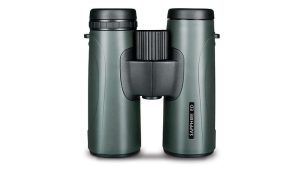 Pros: Excellent image quality rivalling many much more expensive options. Superb wide field of view. Ergonomic, well-balanced magnesium alloy body gives a quality feel while remaining light. Great all-around performer offering superb value.
Pros: Excellent image quality rivalling many much more expensive options. Superb wide field of view. Ergonomic, well-balanced magnesium alloy body gives a quality feel while remaining light. Great all-around performer offering superb value.
Cons: Biggest gripe is the rain guard… which has no bearing on the quality of the binocular, but has a big impact on its usability. This one is far too tight and difficult to remove quickly, to the point of rendering it almost unusable. Initially, I found the eye-positioning a bit finicky, and experienced peripheral blackouts while panning. However, it was fine once I got used to it. Would be nice to see a locking dioptre adjustment on a binocular at this level.
Price: c. €550
Value: Excellent
Rating: Highly Recommended (but you’ll need an alternative rain guard)
Hawke is a brand that has impressed in the past with the quality of its optics at a given price point. Sitting at the pinnacle of the company’s binocular range I was expecting the Sapphire ED to punch above its weight, and I wasn’t disappointed optically. Ergonomically too the binoculars deliver, although I did have a few early niggles with eye-positioning, particularly while panning.
The finish doesn’t perhaps have the finesse of the “best of the best”, but then the Hawke’s come in at less than a third of the price, and more than hold their own against similarly priced competition. High-end materials and features like magnesium alloy housing, ED glass, dielectric prism coatings and hydrophobic protective coatings on external lenses help this binocular perform way above expectations at this price point.
If you’re shopping for a high-performance birding and wildlife binocular, and are looking for performance approaching the best at a mid-range price point, then the Hawke Sapphire ED has a lot to offer.
For full specs and more information on the various Saphire ED models available check out the Hawke UK website here.
Buy the Hawke Sapphire ED on Amazon.co.uk or Amazon.com
Hawke Sapphire ED 8×42: Full Review
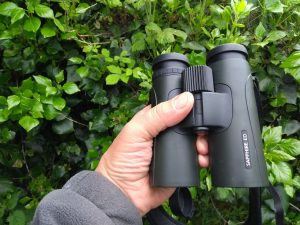 Hawke is a UK based optics brand that has quietly built a reputation over recent years of offering superb optics at a price point that offers outstanding value for money — particularly with their mid-range Endurance and Frontier families optics. So when Hawke said they were sending in their top-of-the-range Sapphire ED for review I was intrigued to see just how good their best would be.
Hawke is a UK based optics brand that has quietly built a reputation over recent years of offering superb optics at a price point that offers outstanding value for money — particularly with their mid-range Endurance and Frontier families optics. So when Hawke said they were sending in their top-of-the-range Sapphire ED for review I was intrigued to see just how good their best would be.
The Sapphire ED comes in three form factors: compacts with 25mm objectives, single top-hinge with 42mm objectives (reviewed here) and a dual- or open-hinge design with 43mm objectives.
All are available in 8x or 10x magnifications, with the two full-size options available with either black or green rubber armour (compacts only come in black).
Balance, Handling and Build Quality
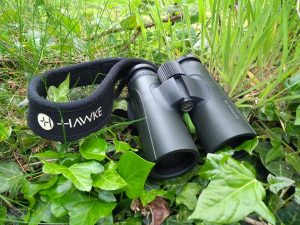 When you pick up the Sapphire ED 8×42 it instantly feels like it’s built to last. It’s solid, without being overly heavy, thanks to a magnesium alloy chassis that’s both lightweight and incredibly strong. The metal housing is covered with a hard rubber armour (available in green or black) that yields ever so slightly to the touch — making the binocular very comfortable to hold, and providing plenty of grip, but perhaps, more importantly, protecting your valuable optics from the inevitable bump or two when out in the field. Conveniently located thumb indents on the underside of this armour help naturally guide your hands to the optimum location for perfect balance.
When you pick up the Sapphire ED 8×42 it instantly feels like it’s built to last. It’s solid, without being overly heavy, thanks to a magnesium alloy chassis that’s both lightweight and incredibly strong. The metal housing is covered with a hard rubber armour (available in green or black) that yields ever so slightly to the touch — making the binocular very comfortable to hold, and providing plenty of grip, but perhaps, more importantly, protecting your valuable optics from the inevitable bump or two when out in the field. Conveniently located thumb indents on the underside of this armour help naturally guide your hands to the optimum location for perfect balance.
The top-hinge design makes this quite a compact full-size binocular… which I really like… and the wrap-around grip it provides make it a very comfortable binocular to use.
It’s not exactly light: at 730g you’ll certainly know you’re carrying it, but the Sapphire ED sits comfortably alongside its peers in this class and is by no means overly heavy for a high-quality optical instrument. Remember the best optical components tend to be weightier than their inferior counterparts… so I’d suggest being wary of any binocular or scope that feels excessively light for its size.
The only slight issue I had with the handling of this binocular was with the central hinge. On the review sample the hinge moved very smoothly and freely — perhaps a little too freely. Occasionally I’d grab the binocular quickly to look at a passing bird, only to find I’d accidentally adjusted the inter-pupillary distance (the space between the two barrels). Adjusting it back is quick and easy… but not quite quick enough: the bird was invariably gone, the moment missed. It’s worth pointing out that this could just be a quirk of this sample, as I haven’t seen reference to this as an issue in other reviews of the same model.
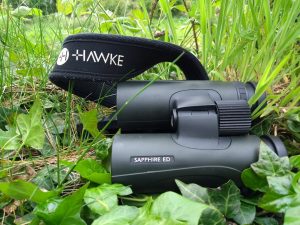 Focus
Focus
The central focus wheel on the Sapphire ED rotates smoothly through about one-and-a-quarter anti-clockwise turns from a sub-2m close focus out to infinity. The surface is finely ribbed, and affords excellent grip, even with gloves on. Focusing is quick, accurate and smooth throughout the range.
Dioptre adjustment
You’ll find the dioptre adjustment dial in the standard location below the right-hand eyepiece. There is no lock (which you often see on higher-end binoculars today), but while the dial moves smoothly, there’s enough resistance to ensure it stays put once set. I never had an issue with the dioptre adjustment moving inadvertently during the review period.
There is a centre arrow, a + and a – marked on the binocular barrel, and a matching arrow on the dioptre adjustment dial. Other than that there’s no scale or markings to allow you to note your ideal dioptre setting and return to it quickly if you lend your binoculars to somebody else.
Eye-cups and Eye Relief
The rubber-coated eyecups of the Sapphire ED twist up and down, with three possible positions (fully in, one intermediary stop, and fully out). They turn smoothly and snap into place with a satisfying click that suggests there’s no danger of them slipping inadvertently.
Most observers will have the eyecups fully twisted out if viewing without eyeglasses, and fully twisted in if viewing with eyeglasses — but the intermediary stop affords an element of flexibility in the setup if needed. Quoted eye relief for the 8×42 Sapphire ED tested here is 18mm — which is quite generous and should mean that most eyeglass wearers can use these with their glasses on and still see the full expanse of the generous field of view.
Weatherproofing
It almost goes without saying that the Hawke Sapphire ED is fully sealed and nitrogen purged, making it impervious to weather, dust and internal condensation/fogging.
Optical Performance
 I’ve been impressed by the optical performance of other models in the Hawke range at their particular price points in the past. But how does the Sapphire, as the best binocular Hawke Optics has to offer, stack up in the image quality stakes? On paper it’s packed with high-end features that rival top-tier binoculars from premium manufacturers — but that doesn’t always translate into performance in the field. Let’s see.
I’ve been impressed by the optical performance of other models in the Hawke range at their particular price points in the past. But how does the Sapphire, as the best binocular Hawke Optics has to offer, stack up in the image quality stakes? On paper it’s packed with high-end features that rival top-tier binoculars from premium manufacturers — but that doesn’t always translate into performance in the field. Let’s see.
Image sharpness and field of view
The image through the Hawke Sapphire ED is very impressive. I never use sterile charts in controlled conditions to test the clarity and resolution of review binoculars (those tests mean very little in real-world use), preferring to test binoculars in real-world field conditions looking at birds and other wildlife.
Bottom line: the view through the Sapphire ED is crisp, clear and bright, allowing you to discern the smallest detail in the subject, even at distance. Add to that the expansive field of view (142m@1000m/c. 8°) and you have a very impressive all-around performer. There is some softening of the field out towards the very edge… but unlike some binoculars with a wide field of view, that never feels like it’s encroaching on the image, and is only noticeable if you really look for it — which you never do in real-world use.
Colour fidelity, contrast and chromatic aberration
Colours look vibrant and natural through the Sapphire ED. They are well balanced, and almost neutral… with perhaps a very slight yellowish bias. Overal though the view is pleasing, feels natural and has excellent contrast that makes the overall image “sing”.
The use of ED glass in the objective lens elements also helps to control the occurrence of chromatic aberration (colour fringing), and while I could induce the effect by focusing on an extremely high-contrast subject and viewing it at the very edge of the field of view, it was never an issue during normal use.
Low light performance and coatings
As you’d expect of any high-performance optical product the Sapphire ED is fully multi-coated (FMC) with all glass surfaces coated with multiple layers of anti-reflective, high-transmission coatings to improve the amount of light passing through the optical system and reaching your eye.
The use of special dielectric mirror coatings and phase correction coatings on the roof prisms help maximise light transmission and resolution even further. The result is an exceptionally bright image that delivers maximum detail well into twilight and beyond.
While it’s not quite on a par with the very best in terms of light transmission, the Sapphire ED’s performance certainly isn’t far behind. At this price, it’s a very impressive performer indeed.
One last thing that’s worth a mention — the Sapphire ED includes a protective, hydrophobic coating on the external lens surfaces — an option now found on many high-end binoculars. It serves to protect the more delicate coatings beneath, causes water to simply bead and roll off and makes it harder for dirt and grease to stick. The result is lenses that stay cleaner for longer, and that are much easier to clean when they need it.
This might sound trivial — but trust me, once you’ve owned a binocular with this feature you won’t look at a one without it.
Accessories
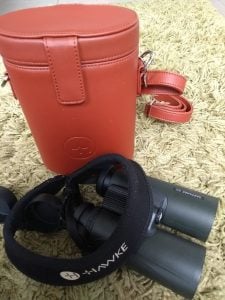 The Sapphire ED comes with the usual suite of accessories: a case, a padded neoprene neck strap, an eyepiece rainguard, tethered objective lens covers and a microfibre cleaning cloth.
The Sapphire ED comes with the usual suite of accessories: a case, a padded neoprene neck strap, an eyepiece rainguard, tethered objective lens covers and a microfibre cleaning cloth.
Of these, the most notable is the case. Rather than the standard cordura-style soft case you expect with modern binoculars, Hawke has gone for a more nostalgic rigid case made of real leather. The case is a beautifully crafted, high-quality item in its own right, and lends the entire package a feel old-school prestige.
Of course, if, like me, you use your binoculars daily, then the case will spend its life sitting empty in a cupboard. That really is a shame in this instance — but a binocular in a case isn’t ready to use… and a binocular that’s not ready to use is, well… useless. Still, you can’t help feeling that if Hawke poured so much attention to detail into their case, they must have invested similar energy into the binocular — which is all good.
It’s just a shame they didn’t afford the same level of scrutiny to the eyepiece rainguard: a small yet critically important accessory that has a disproportionate effect on the binocular’s usability.
Here in Ireland it rains… a lot. The role of an eyepiece cover is to keep rain (and/or dust, crumbs or other debris) from getting onto the occular lenses, where it would obscure your view when you want to use your binoculars. This eyepiece rainguard does that job just fine — fitting snuggly over the eyecups and keeping out the elements.
Where it fails is that it fits too snuggly.
The other crucial characteristic for an eyepiece cover on a pair of binoculars is that you can remove it seamlessly (ideally with the casual flick of a finger or thumb) when you want to look at something. That simply isn’t possible with this accessory.
Removing the rainguard takes a conscious effort and precious seconds. That’s fine when your subject is a sailing boat on the horizon, a golfer on the 18th green or even a racehorse careering around a track. It’s not fine when you’re trying to get on a raptor hurtling past at speed, or an elusive vagrant warbler flitting about in the canopy of a woodland.
If I was using the Hawke Sapphire ED as my main birding and wildlife binocular (optically and ergonomically there’s absolutely no reason why I wouldn’t) I would have to find an alternative to the rainguard. Something, perhaps, for Hawke’s product designers to consider for the future.
Warranty
Hawke Optics offers a limited lifetime warranty on all its optics (legally limited to 10 years within Europe). You’ll find full warranty details on the Hawke website here.
Conclusion
With the Sapphire ED Hawke proves that it’s commitment to outstanding optical quality at price points that offer exceptional value extends all the way up to the top model in the company’s range. The Sapphire ED delivers top-tier optical performance and excellent ergonomics and build quality at a price that’s hard to beat for comparable features.
This is an exceptional binocular that, while not quite reaching the upper echelons of optical excellence found in the very best binoculars, comes remarkably close, and at a fraction of the price.
If you’re looking for a top-quality binocular at a mid-range price point, you really need to put the Hawke Sapphire ED on your shortlist.
Buy the Hawke Sapphire ED on Amazon.co.uk or Amazon.com
Specifications
From the manufacturer’s website:
Nitrogen Purged – Waterproof and Fog Proof.
Acknowledgements
I’d like to thank Hawke Optics for providing the Sapphire ED 8×42 for review on Ireland’s Wildlife.
NB. Ireland’s Wildlife has no specific affiliation to any optics or gear manufacturer and all reviews on the site are completely independent and objective. If you’re an optics or gear manufacturer and would like to submit your product for review on the site please drop us a line using the contact form and we can take things from there.










4 comments
Dawid Cichy
And have you tried those binos with the night sky /stars?
Calvin Jones
The sapphire, like the Frontier EDX from Hawke, is an excellent all-around performer and offers superb value as a high-performance binocular for birding and wildlife observation. It also works well for looking at the night sky — the high resolution, excellent contrast and an almost complete absence of chromatic aberration means start are pin-sharp and clear, and the field of view is comfortably wide without sacrificing image quality at the periphery. The Sapphire has now been discontinued and replaced at the top of the Hawke like by the Frontier EDX which is another superb option for astronomical use.
goodhanduae
I am planning to buy Steiner Ranger Xtreme 8×42 Binocular
42 mm
8 x
780 g
Width 125 mm
Height 147 mm
Depth 63 mm
5.25 mm
27.60
18.3
Field of View at 1000 m 125 m
Fast-Close-Focus
1.9 m
-20°C to +80 °C
twist-up eyecups
Objective Cover Yes
Rain Protection Cap Yes
Bag Yes
Warranty 10 years
8X42 Binoculars.
Calvin Jones
I was sent a pair of Steiner Skyhawk binoculars to review… sent them back unreviewed… singularly unimpressed with their performance at that price point. Hope you have better luck with the XTreme.